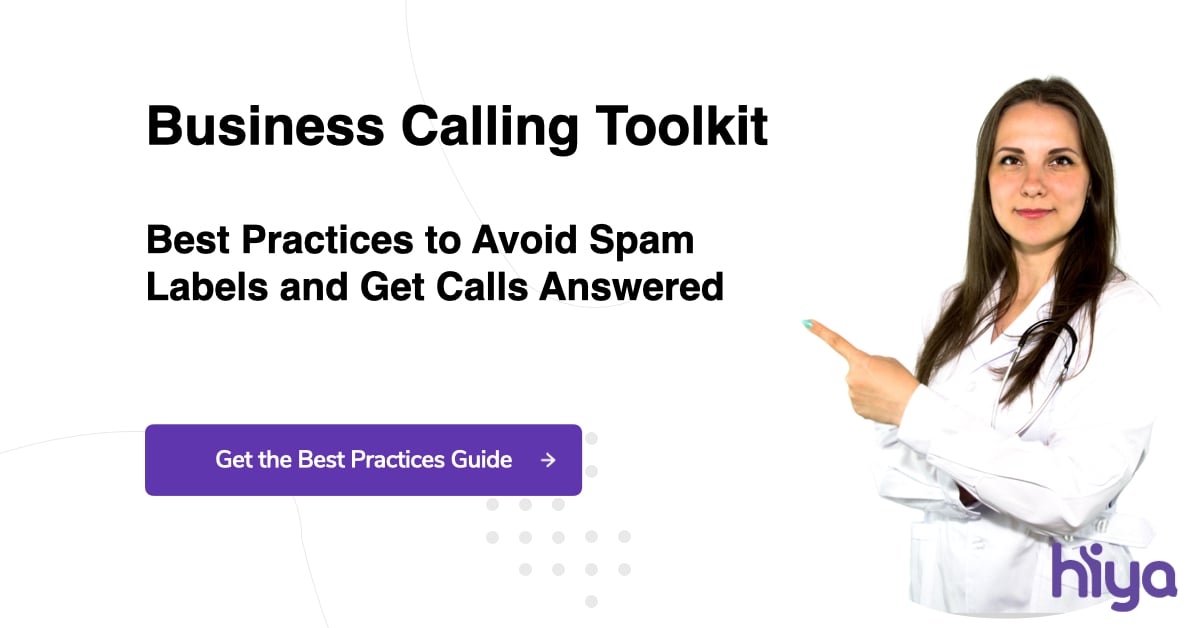Getting customers to pick up the phone is becoming increasingly more difficult, and part of this is due to the high number of spam calls. Hiya’s research in the State of the Call Report found that consumers in North America and Western Europe were hit by an average of 144 spam calls in 2020. This equates to approximately 157 billion spam calls in just these regions!
Many platforms and service providers label these numerous spam calls with a “spam risk” label on their caller ID to protect their customers from spammers. To avoid being labeled as a fraudulent call, high-volume callers from legitimate businesses need to actively follow a few best practices.
What Is a High-Volume Caller?
If your call center is making more than 20,000 outbound calls a month, then you’re a high-volume caller and you need to make sure your calls aren’t being labeled as spam. Because you are making so many calls, this gives customers and providers more opportunities to report your numbers as spam.
Having spam labels attached to your numbers can have disastrous results for your answer rates and overall customer satisfaction. Your customers won’t usually answer a call that has a warning on it, which will lead to a lack of communication. When that customer doesn’t receive the call they are expecting from you, they become dissatisfied with your business.
Why Do Your Calls Get Flagged as Spam?
In response to the increase in fraudulent calls, the Federal Communications Commission (FCC) has passed numerous legislation to protect consumers. Call centers work to be compliant with these acts, but even with your extra effort, you may have some numbers get flagged.
As a high-volume caller, there are a few ways your outbound calls can get flagged. Consumers can block your number, apps on consumers’ phones can flag numbers for suspicious behavior, and carriers can detect unusual call patterns.
Consumers
When incoming calls are unknown, some customers will block these calls without ever answering the phone. If your number is blocked enough times, then your number will have the “spam risk” label attached to it. Being left at the mercy of customers who are used to receiving fraudulent calls can be frustrating for high-volume callers who have a legitimate need to contact people.
Call-Blocking Apps
In addition to consumers who report or block callers directly from their phones, many apps have been developed to allow customers to identify, report, or block incoming calls. Some of these apps are inaccurate due to advanced algorithms and a high dependency on customer reports. In these instances, you may be seeing your numbers receive negative labels despite having legitimate businesses reasons to be calling your customers.
However, not every call-block app will result in your business receiving false labels. The Hiya app has the lowest error rate in the industry because of our advanced spam detection that goes far beyond a static caller registry. Advanced machine learning models analyze reputation along 22 different dimensions to better protect consumers and provide businesses full visibility into their numbers' reputation status.
Carriers
Service providers often use algorithms to identify patterns and many partners with spam detection partners to prevent fraudulent calls from ever reaching their customers. As we learned above, some platforms are more accurate than others when it comes to spam detection.
Some spam filters catch high-volume callers because they often have calling patterns that are similar to spammers. Some carriers will watch for how many calls in a certain amount of time they get from a phone number. If it exceeds a certain limit, then it’s determined that the number is likely a robocall.
How Do You Avoid Getting Flagged?
Without a clean call reputation, you won’t be able to get through to your customers. You can’t change the frequency or volume of your calls without negatively impacting your call center productivity, so how do you avoid spam labels?
Know the Regulations
A key way to avoid negative labels is to comply with the regulations established by the Federal Communications Commission (FCC). The FCC has numerous regulations that high-volume callers need to follow to avoid spam labels and potential lawsuits.
One regulation to highlight is the Telemarketing Sales Rule (TSR) that states telemarketers cannot contact people on the National Do Not Call Registry. Be sure to follow this principle with your customers and don’t contact them if they’ve asked not to be called. Continuing to contact customers who don’t want to be reached will only result in them blocking your number.
In addition, the U.S. regulation for using a dialer requires at least 4 rings or 15 seconds before hanging up. Be sure to follow this time condition to avoid looking like a spammer.
Maintain User Experience
If you can get your customers to answer your calls or call you back, then you are breaking out of the patterns associated with scammers. In addition, this quality experience and knowledge of who’s calling will prevent customers from blocking your number.
One strategy to avoid negative labels is to track the time of day your customers are more likely to answer the phone. As your answer rates increase, your calls appear less like spam calls. If your customer doesn't answer, leave a voicemail to let them know who you are and why you’re calling. This way they are less likely to block you just because the number is unidentified.
Additional Strategies
In addition to following FCC regulations and keeping customer experience top of mind, there are a few other strategies you can employ to steer clear of “spam risk” labels.
Make sure your numbers are in the Caller ID Name (CNAM) database. This signifies to carriers that your number is being used for legitimate business purposes. Also, avoid calling the same number more than a few times a day. That is classic spam behavior that legitimate call centers should avoid.
One extremely effective way to eliminate the possibility of receiving false spam labels is to display branded caller ID with Hiya Connect. Branded calls allow customers to instantly recognize who is calling by the company name, logo, and location that is displayed. In addition to showing your identity, you can include a reason for your call to set customer expectations from the beginning. Hiya Connect also provides businesses full visibility into their numbers' reputation status.
Now that you know more about how spam labels work and what triggers them, you’re better equipped to evade false spam labels as a high-volume caller. However, we only included in this article a fraction of the tactics we’ve discovered. There are even more ways you can avoid “fraud risk” warnings—eight more ways to be exact. Get all our actionable tips in Hiya’s Best Practices to Get Calls Answered eBook.




